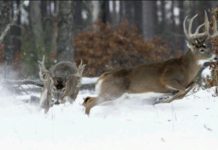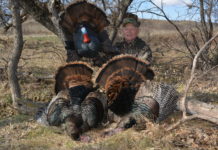A few years ago, I hunted with Michael Waddell (before he became a superstar). We had a great tree stand location at the corner of an alfalfa field, but deer kept passing through a gate about 50 yards from the stand, frustrating our efforts for a quality shot. Discussing the dilemma with the landowner, the farmer said nonchalantly, “Why don’t you close the gate?” Duh! What a great idea. We took that advice and forced a mid 140s buck to jump the fence right in front of our stand.
Whether you hunt in the East or West, fences are a part of a whitetail habitat, so use them to your advantage. Well-known outdoor writer Bob Robb covers all the options in this informative piece for Deer & Deer Hunting.
For a long time, I looked at fences on hunting land as a real pain. All they seemed to do was hold up gates I had to keep opening and closing, or rip my pants and shirts when I tried to go over them.
Then I began talking with landowners about fences, and how they might be used as a positive in my deer hunting. Today, my attitude has changed. I still hate to open and close gates, but I have learned that fences can be a real tool in an archer’s war chest.
Fence Crossings
Fences are nothing more than man-made boundaries. They mark property lines, as well as help section off land into various different uses. They keep cattle, horses and other large domestic animals confined to certain areas and, more importantly, out of others.
Fences can serve other functions, too, and they aren’t all made from wire and steel posts. For example, rock walls can help shore up creek banks and water holes. And when woods are cleared, the resulting detritus can be pushed up to form a barrier along field edges.
All types of fence barriers can be used to your advantage when bow hunting. The most obvious is to locate trails that indicate places where deer frequently cross a fence. Depending on conditions and the time of year, these fence crossings can be excellent places to set a stand.
Tell us what you think in the comments section below.



















![The Best Deer Camp Chili [VIDEO] Deer Chili Ingredients, Tomatoes, Chili Spices](/wp-content/uploads/2015/10/Deer-Chili-Deer-Camp-Recipe-218x150.jpg)
![How to Call Elk Early in the Season [VIDEO]](/wp-content/uploads/2016/08/byers003-218x150.jpg)

![fence-jumper-todd-hostetter[1]](/wp-content/uploads/2014/08/fence-jumper-todd-hostetter1.jpg)


![Idiots Disturb Hunter: How Would You Have Handled It? [VIDEO]](/wp-content/uploads/2015/10/DSC00110-e1474487693878-100x70.jpg)
![Albino Buck Shocked to Shed His Antlers [VIDEO]](/wp-content/uploads/2015/10/AlbinoDeer-100x70.jpg)